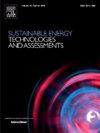Improvement of energy utilization in residential districts at the early design stage: Achieving lighting self-sufficiency of buildings through a PV-DC power distribution system
IF 7
2区 工程技术
Q1 ENERGY & FUELS
Sustainable Energy Technologies and Assessments
Pub Date : 2025-06-16
DOI:10.1016/j.seta.2025.104402
引用次数: 0
Abstract
Improvement of energy utilization through effective technologies and reasonable distribution plays an important role in the construction of energy residential districts. Many studies have proposed different decision tools for improving the solar energy potential based on detailed residential information. However, there is still a lack of decision-making tools to use less residential information for optimizing energy planning towards achieving energy self-sufficiency at the early design stage. Therefore, this study proposed an evaluation framework to divide energy groups in residential districts, aiming to achieve the lighting self-sufficiency of residential buildings from a photovoltaic-direct current (PV-DC) power distribution system. This distribution system can transfer surplus PV power from power-rich buildings to power-deficient buildings. An evaluation index (the standard number of building floors) was defined to estimate the surplus PV power for residential buildings and optimize energy proposals. A real residential district in Nanning City was selected as a case study to demonstrate the process of the proposed evaluation framework. The analysis results revealed that nine out of 10 residential areas are lighting self-sufficient using the PV-DC power distribution system. Moreover, even if the lighting electricity demand increases by 50% and PV conversion efficiency decreases by 25%, the identified energy groupings in the study district can still achieve zero-energy lighting with low delivery distance cost and high PV power redundancy. Therefore, the proposed evaluation framework can be used as a design support tool for urban designers to identify residential proposals with zero-energy lighting at the early design stage, which is conducive to further improving energy utilization in the construction and operation stages.
改善住区设计初期的能源利用:通过PV-DC配电系统实现建筑物的照明自给
通过有效的技术和合理的布局来提高能源利用率,对节能小区建设具有重要意义。许多研究基于详细的住宅信息提出了不同的决策工具来提高太阳能潜力。然而,在早期设计阶段,仍然缺乏决策工具来使用较少的住宅信息来优化能源规划,以实现能源自给自足。因此,本研究提出了一个评估框架来划分住宅小区的能源组,旨在通过光伏-直流(PV-DC)配电系统实现住宅建筑的照明自给。该配电系统可以将富余的光伏电力从富余的建筑输送到缺电的建筑。定义了一个评价指标(标准建筑层数)来估算住宅光伏剩余电量,并优化能源方案。以南宁市的一个真实住宅小区为例,展示了所提出的评价框架的过程。分析结果显示,10个住宅小区中有9个使用PV-DC配电系统实现照明自给自足。此外,即使照明用电需求增加50%,光伏转换效率降低25%,研究区内确定的能源分组仍然可以实现零能耗照明,且输送距离成本低,光伏电力冗余度高。因此,本文提出的评价框架可以作为城市设计师在设计初期识别零能耗照明住宅方案的设计支持工具,有利于进一步提高建设和运营阶段的能源利用率。
本文章由计算机程序翻译,如有差异,请以英文原文为准。
求助全文
约1分钟内获得全文
求助全文
来源期刊

Sustainable Energy Technologies and Assessments
Energy-Renewable Energy, Sustainability and the Environment
CiteScore
12.70
自引率
12.50%
发文量
1091
期刊介绍:
Encouraging a transition to a sustainable energy future is imperative for our world. Technologies that enable this shift in various sectors like transportation, heating, and power systems are of utmost importance. Sustainable Energy Technologies and Assessments welcomes papers focusing on a range of aspects and levels of technological advancements in energy generation and utilization. The aim is to reduce the negative environmental impact associated with energy production and consumption, spanning from laboratory experiments to real-world applications in the commercial sector.
 求助内容:
求助内容: 应助结果提醒方式:
应助结果提醒方式:


